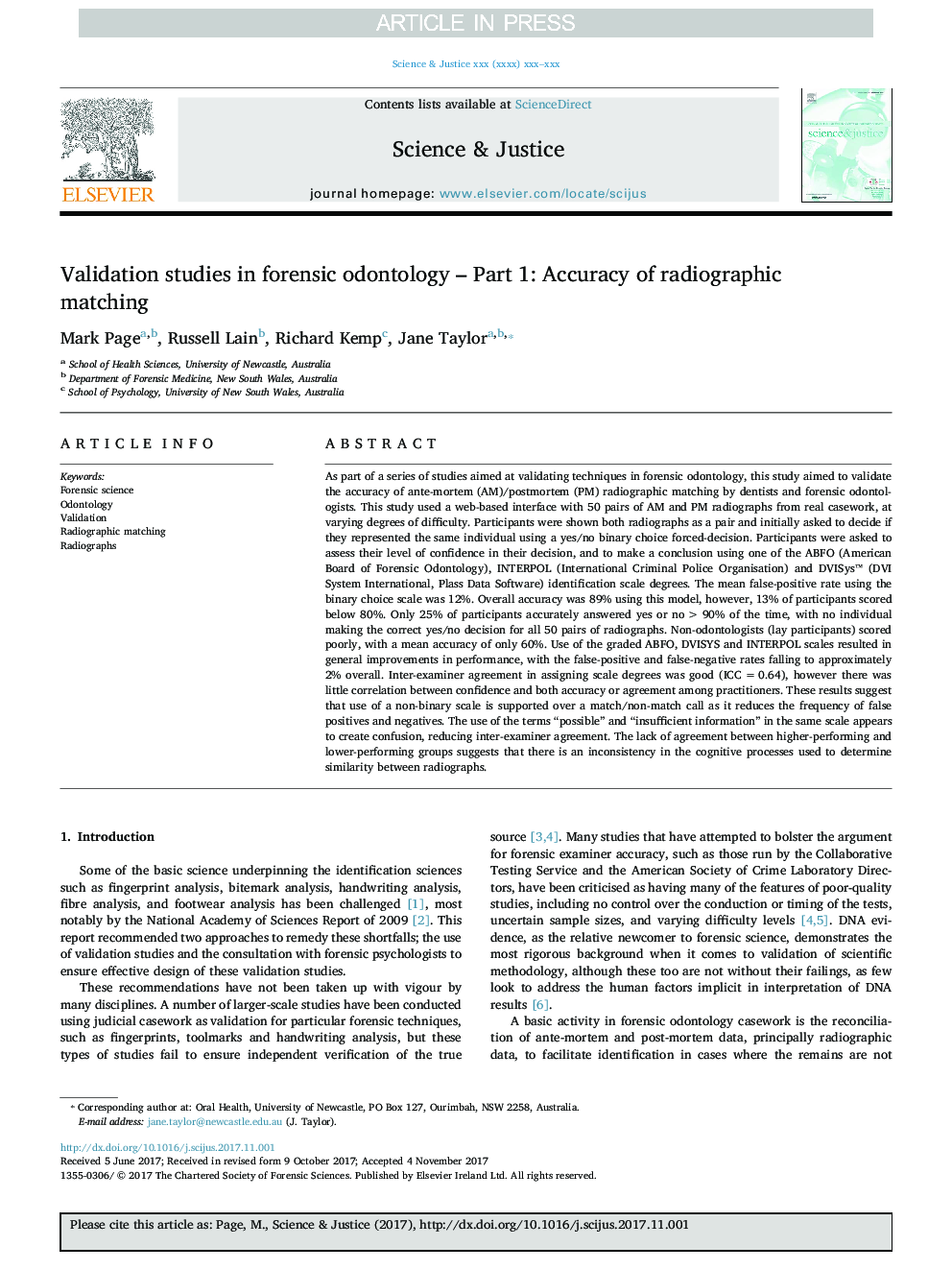| کد مقاله | کد نشریه | سال انتشار | مقاله انگلیسی | نسخه تمام متن |
|---|---|---|---|---|
| 6555891 | 1422498 | 2018 | 6 صفحه PDF | دانلود رایگان |
عنوان انگلیسی مقاله ISI
Validation studies in forensic odontology - Part 1: Accuracy of radiographic matching
ترجمه فارسی عنوان
مطالعات اعتبار سنجی در دندانپزشکی قانونی - قسمت 1: دقت تطابق رادیوگرافی
دانلود مقاله + سفارش ترجمه
دانلود مقاله ISI انگلیسی
رایگان برای ایرانیان
کلمات کلیدی
علم قضایی، دندانپزشکی، اعتبار سنجی، تطابق رادیوگرافی، رادیوگرافیها،
موضوعات مرتبط
مهندسی و علوم پایه
شیمی
شیمی آنالیزی یا شیمی تجزیه
چکیده انگلیسی
As part of a series of studies aimed at validating techniques in forensic odontology, this study aimed to validate the accuracy of ante-mortem (AM)/postmortem (PM) radiographic matching by dentists and forensic odontologists. This study used a web-based interface with 50 pairs of AM and PM radiographs from real casework, at varying degrees of difficulty. Participants were shown both radiographs as a pair and initially asked to decide if they represented the same individual using a yes/no binary choice forced-decision. Participants were asked to assess their level of confidence in their decision, and to make a conclusion using one of the ABFO (American Board of Forensic Odontology), INTERPOL (International Criminal Police Organisation) and DVISys⢠(DVI System International, Plass Data Software) identification scale degrees. The mean false-positive rate using the binary choice scale was 12%. Overall accuracy was 89% using this model, however, 13% of participants scored below 80%. Only 25% of participants accurately answered yes or no > 90% of the time, with no individual making the correct yes/no decision for all 50 pairs of radiographs. Non-odontologists (lay participants) scored poorly, with a mean accuracy of only 60%. Use of the graded ABFO, DVISYS and INTERPOL scales resulted in general improvements in performance, with the false-positive and false-negative rates falling to approximately 2% overall. Inter-examiner agreement in assigning scale degrees was good (ICC = 0.64), however there was little correlation between confidence and both accuracy or agreement among practitioners. These results suggest that use of a non-binary scale is supported over a match/non-match call as it reduces the frequency of false positives and negatives. The use of the terms “possible” and “insufficient information” in the same scale appears to create confusion, reducing inter-examiner agreement. The lack of agreement between higher-performing and lower-performing groups suggests that there is an inconsistency in the cognitive processes used to determine similarity between radiographs.
ناشر
Database: Elsevier - ScienceDirect (ساینس دایرکت)
Journal: Science & Justice - Volume 58, Issue 3, May 2018, Pages 185-190
Journal: Science & Justice - Volume 58, Issue 3, May 2018, Pages 185-190
نویسندگان
Mark Page, Russell Lain, Richard Kemp, Jane Taylor,
